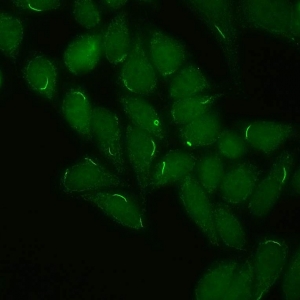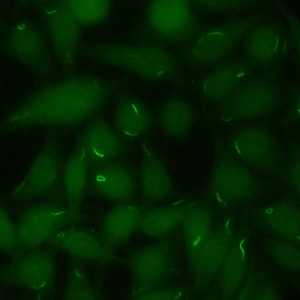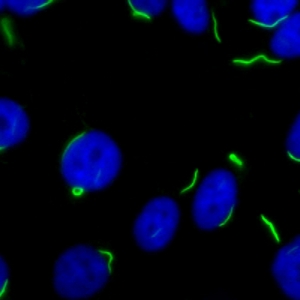AC-23 - RODS and RINGS
Descrição
Distinct rod and ring structures in the cytoplasm of interphase cells. Some smaller rods and rings also reported in the nucleus.
Associação Antigênica
IMPDH2
Doença Associada
HCV patients post-IFN/ribavirin therapy, rare in SLE, Hashimoto`s and healthy controls
Relevância Clínica (Primeiro Nível)
Most commonly found in HCV patients who have been treated with pegylated interferon-?/ribavirin combination therapy, but autoantibodies revealing the AC-23 patterns were undetected prior to treatment; as the use of interferon-?/ribavirin in HCV treatment is decreasing, the frequency and clinical associations of the AC-23 pattern may change
Specific immunoassays to detect autoantibodies directed to specific Rods and Rings antigens, for instance IMPDH2, are not commercially available
Presence of the AC-23 pattern depends on the HEp-2 cell substrate.
Relevância Clínica (Segundo Nível)
HCV patients positive for the AC-23 pattern have been reported to have disease that is more resistant to therapy, but this is not confirmed in other cohorts
The AC-23 pattern has also been reported rarely in individuals without HCV infection, including SLE patients and patients under treatment with mycophenolic acid, azathioprine, methotrexate or acyclovir, as well as with lower titers in the general population
Referências
Covini G, Carcamo WC, Bredi E, et al. Cytoplasmic rods and rings autoantibodies developed during pegylated interferon and ribavirin therapy in patients with chronic hepatitis C. Antivir Ther 2012;17:805–11.
Calise SJ, Keppeke GD, Andrade LE, et al. Anti-rods/rings: a human model of drug- induced autoantibody generation. Front Immunol 2015;6.
Novembrino C, Aghemo A, Ferraris Fusarini C, et al. Interferon-ribavirin therapy induces serum antibodies determining ’rods and rings’ pattern in hepatitis C patients. J Viral Hepat 2014;21:944–9.
Keppeke GD, Calise SJ, Chan EK, et al. Anti-rods/rings autoantibody generation in hepatitis C patients during interferon-?/ribavirin therapy. World J Gastroenterol 2016;22:1966–74.
Satoh M, Chan EKL, Ho LA, et al. Prevalence and sociodemographic correlates of antinuclear antibodies in the United States. Arthritis Rheum 2012;64:2319-27.
Climent J, Morandeira F, Castellote J, et al. Clinical correlates of the "rods and rings" antinuclear antibody pattern. Autoimmunity 2016;49:102-8.
Keppeke GD, Prado MS, Nunes E, et al. Differential capacity of therapeutic drugs to induce Rods/Rings structures in vitro and in vivo and generation of anti-Rods/Rings antibodies. Clin Immunol 2016;173:149-56.






